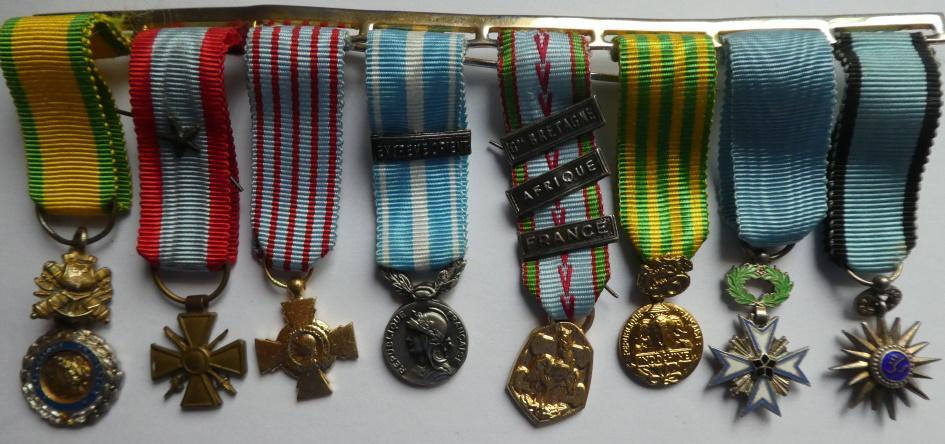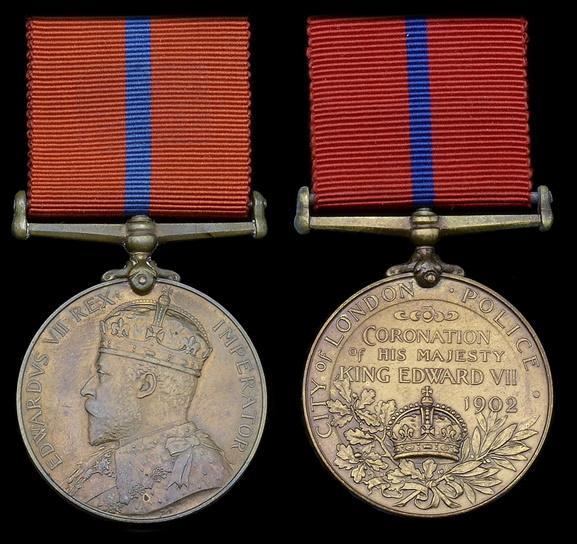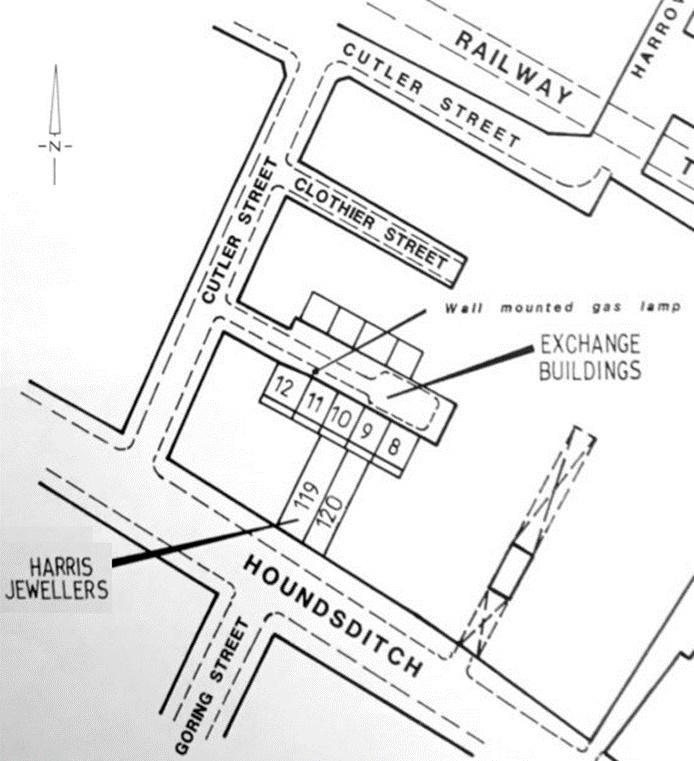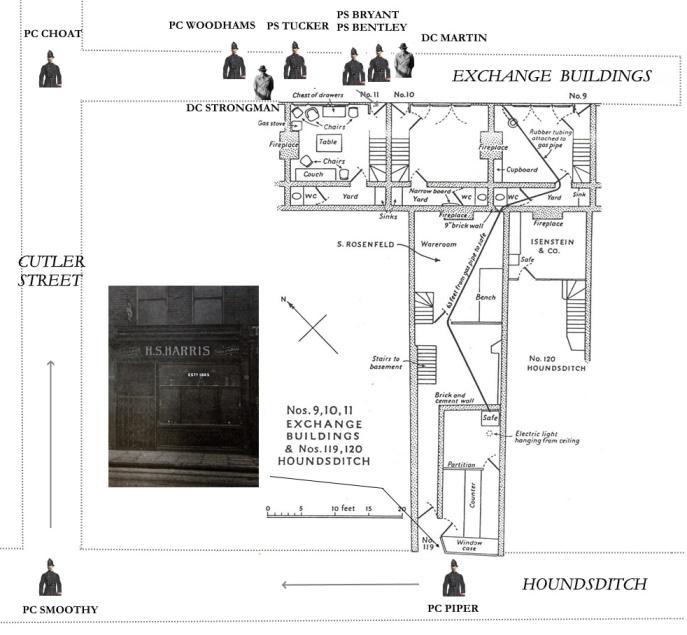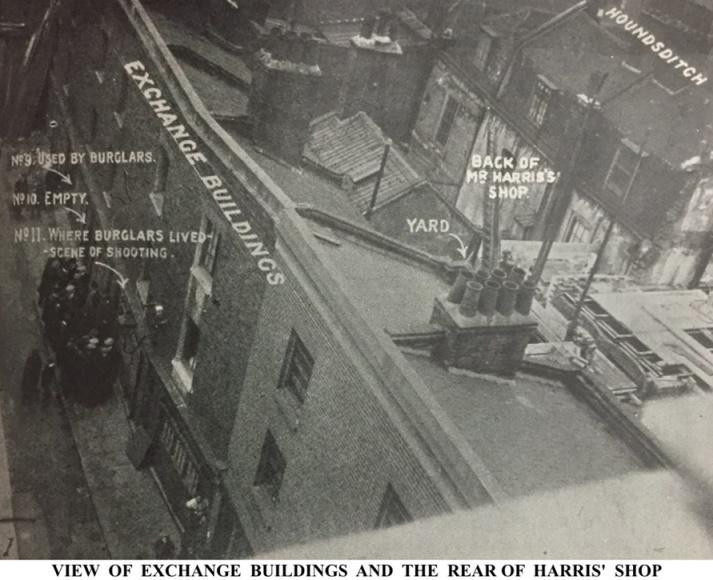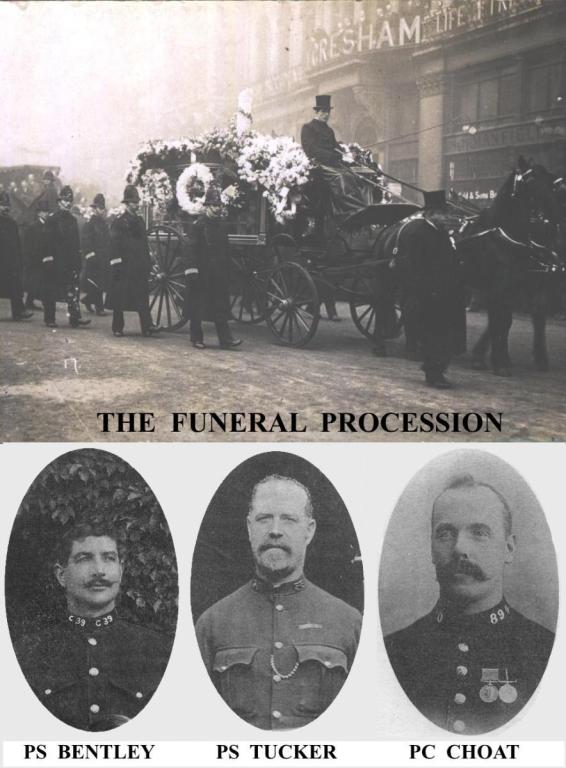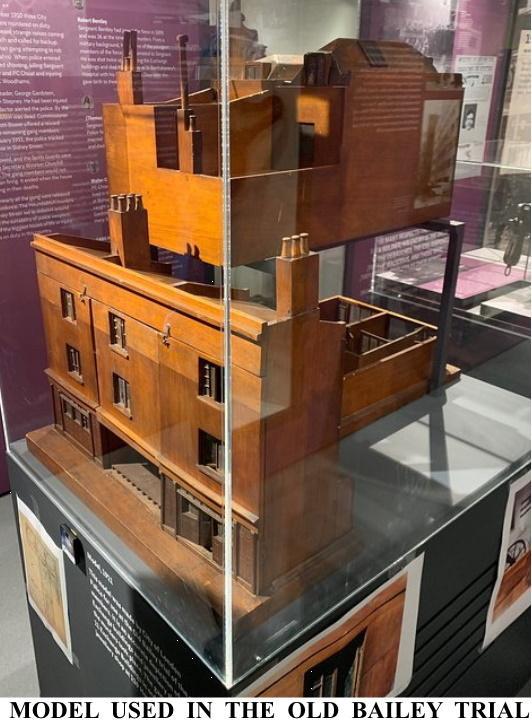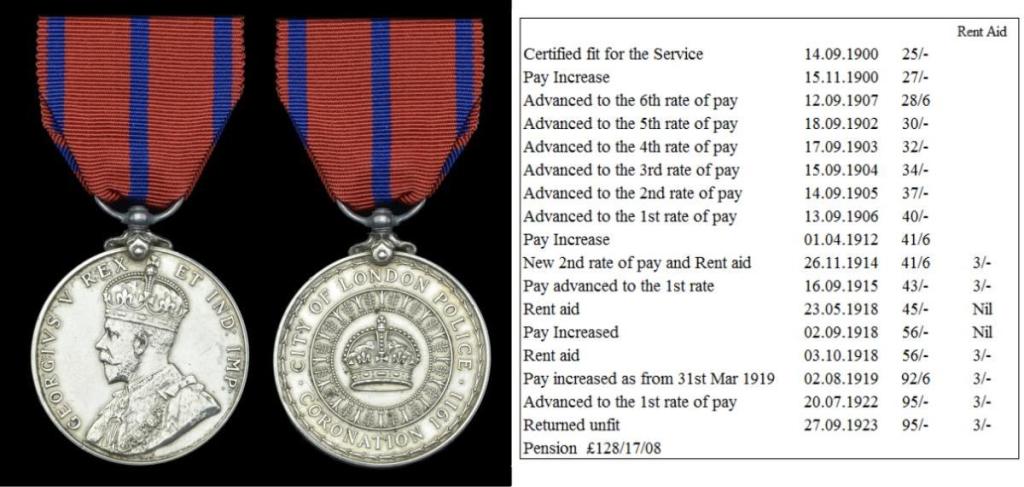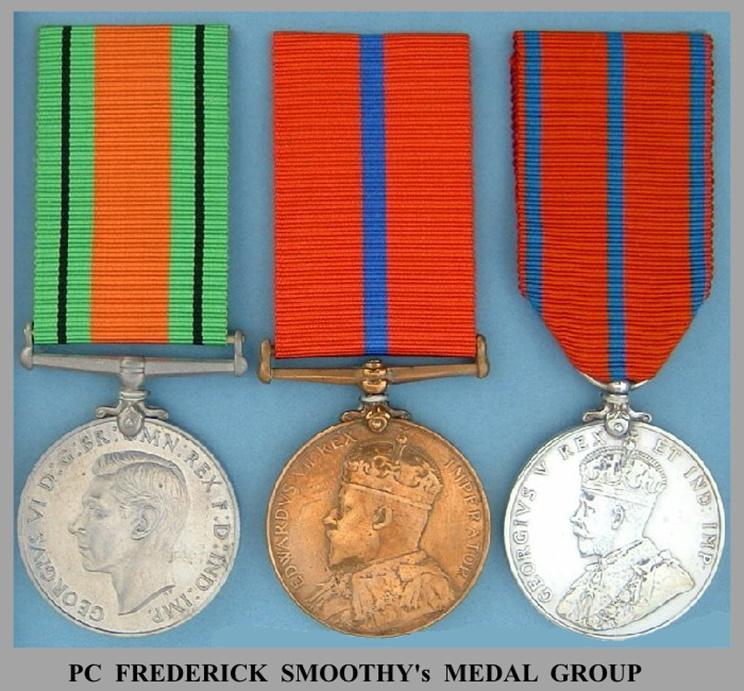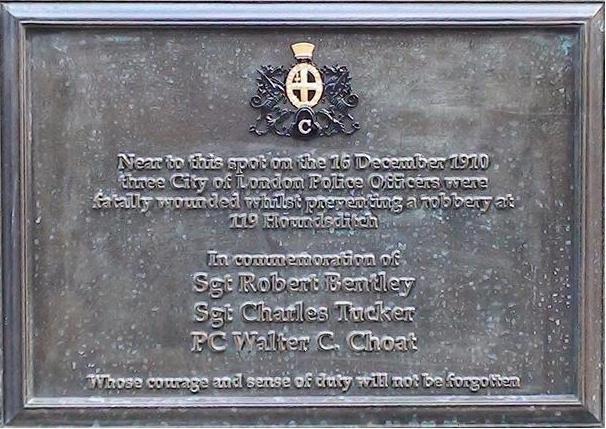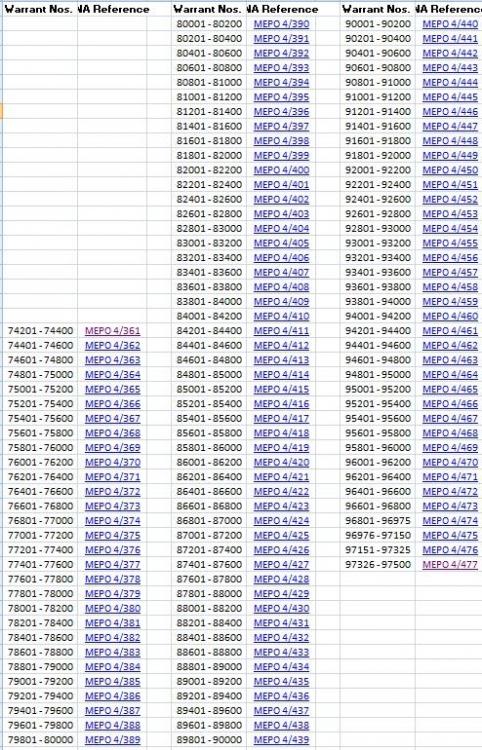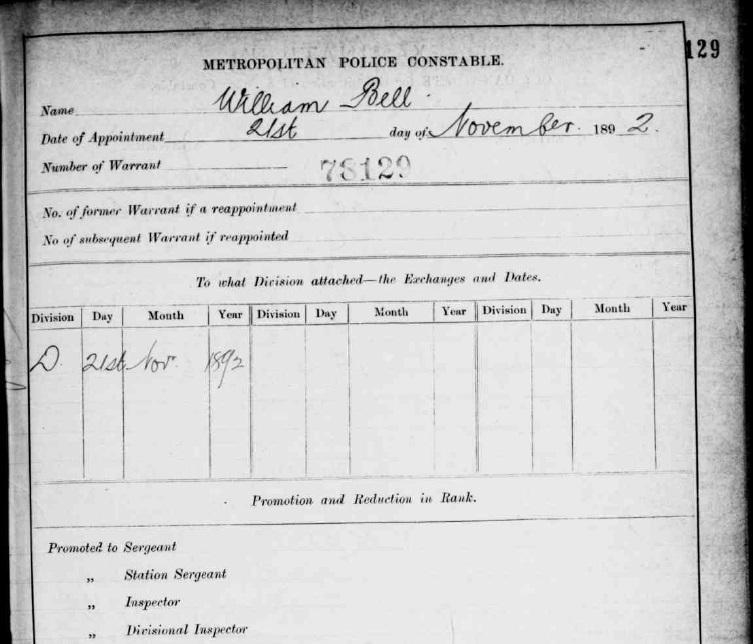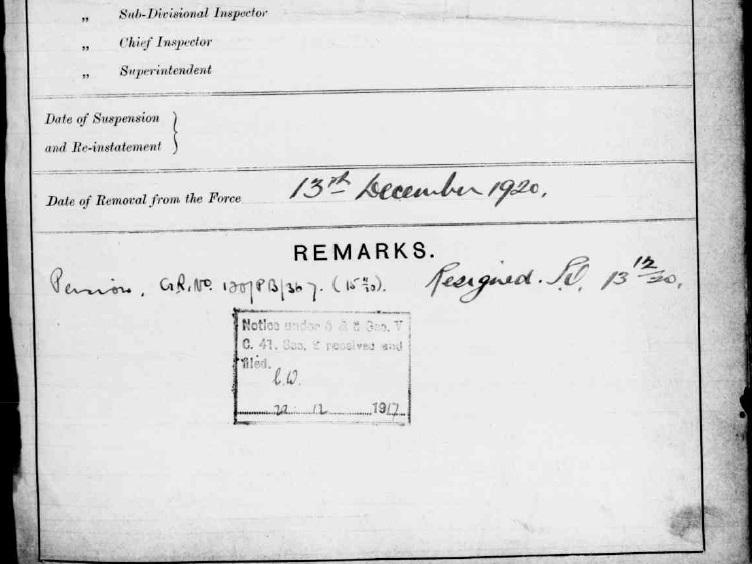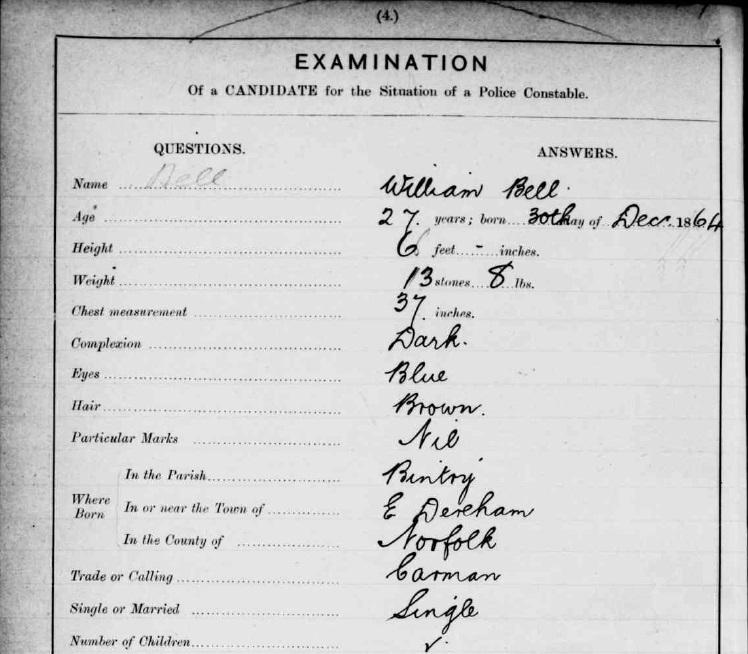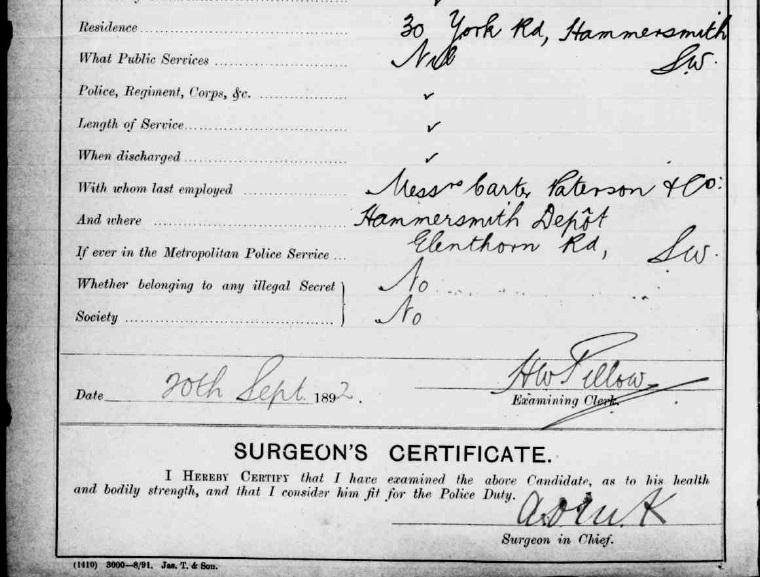-
Posts
276 -
Joined
-
Last visited
Content Type
Profiles
Forums
Blogs
Gallery
Events
Store
Everything posted by Odin Mk 3
-
Thanks very much Owain. Unfortunately the friend only have a couple of the full size medals (Medaille Militaire and Order of the Black Star) and not the whole full size group Jim
-
Just seen this group of minis belonging to a friend - her father earned them and started as a French Army Chef pre WWII. Can anyone tell me what the last medal is please. Not sure how he got the Order of the Black Star but have seen the paperwork for most of the others.
-
I know Simon Eyre so I contacted him about this. He has said he is happy for me to share with you his reply. The problem here is with deciphering the Warrant Book. I read him as George Frederick LUFF Warrant number 5713 Looks like he kept the Collar number 663 through to the end of his service. Started 20th March 1884 and resigned due to ill health 26th January 1888. I'm pretty sure the naming should be Luff rather than Duff but would be good to see the naming on the medal. He has sent me a copy of part of the page but is wary of me posting it here because of copyright issues with the records. However I can assure you it definitely says Luff and not Duff. So his entry is in Simon's book (page 144). I hope that helps you resolve this query Boudica and enables you to further research the man.
-
I've just converted an AGS ribbon into a black and white image. There is not much difference between the black and green stripes but the yellow background does not appear as totally white as the image you put up - so I'd agree it's an NGS.
- 7 replies
-
1
-
- police pillar
- hull city police
-
(and 1 more)
Tagged with:
-
Following on from Alan Baird's excellent post on the Houndsditch and the Sidney Street Siege here is my take on the Houndsditch Murders from the perspective of PC Frederick Smoothy who was one of the officers who was at the scene at the time of the shooting. This was my input for the OMRS Virtual Convention in 2020 and is still available on their Website but unfortunately is only viewable by OMRS members. I am posting it here to allow others who may be interested to access it. I have had to leave out some of the photos as there were a lot which were embedded in the text which I can't easily achieve on this site. It will take me a while to upload all the text so please wait until it is complete. Thank you. INTRODUCTION Frederick William Smoothy was an unmarried City of London policeman who was based at Bishopsgate Police Station. He was on duty on the evening of 16th December and was one of the officers who were involved in an incident near Houndsditch which resulted in one of largest multiple murders of police officers ever carried out in Britain. Some of the unmarried Policemen killed or wounded were not only his colleagues they also lived in the same accommodation at Bishopsgate as PC Smoothy. The medals that he received are those which all officers serving in the City of London Police at that time would have received. However his group of medals acted as a trigger for me to research the man. In doing so I discovered he was involved in a case that shocked the whole of Britain and is now referred to as The Houndsditch Murders. EARLY LIFE Frederick was born in 1877 in the village of Galleywood near Chelmsford in Essex. His father, Charles, described himself in the 1881 Census as a Farmer of 187 Acres employing four men and four boys. Frederick was one of eleven children born to Charles and Catharine Smoothy whose family comprised six girls and five boys. By 1891 the family had moved to Old Riffhams in Little Baddow. Charles Smoothy is still recorded as a Farmer with two of his sons, Charles and Frank, working for him. Frederick stayed with his family until 1899 when he moved to London. In August 1899 he started working for the London and North Western Railway Company. From Oct 1899 he was employed at Broad Street Station as a Porter. This was a major terminal station in the City of London, close to Liverpool Street Station. Usage was at its peak in the early 20th century but it later suffered from competition, mainly from the London Underground; it finally closed in 1986. The station was demolished and was redeveloped as the Broadgate office and shopping complex. Having worked for the L.N.W.R. for eleven months Frederick Smoothy applied to join the City of London police. In his application form to join the Police, Smoothy gave Mr R Castleman the Traffic Superintendent at Broad Street Station as his principal referee with supporting testimonials from people who had known him in Little Baddow, the local Vicar and a Police Sergeant. Candidates for the City of London Police had to pass a strict medical and meet a number of conditions: be between 20 and 27 years old, be at least five foot ten inches in height without shoes, not have more than two children, be able to read and write legibly and be prepared to reside within the City of London during their time in the Police Service. Frederick Smoothy completed the necessary paperwork for his application on 20th July 1900. HIS EARLY DAYS IN THE POLICE PC Smoothy joined the City Police on a pay of twenty five shillings a week (£1.25). He was allocated the Warrant Number 7136 and his helmet and collar numbers appears to have been 999. This was then changed to 399, probably around 1909 when new helmet plates were introduced. These had a trefoil shaped number plate which incorporated a letter to indicate which division the man was serving in; the letter C was used to designate Bishopsgate officers. Smoothy’s number was again changed to 299 later in his police career which possibly aligns with the practice in the Metropolitan Police of giving lower collar numbers as they become available to PCs with more years service. Interestingly the City of London Police still use the original dies to manufacture their helmet plates although the central design now has gold colour baked onto it and anodized (Staybrite) letter and numbers have replaced the previous brass material. The 1901 Census shows Frederick Smoothy living in police accommodation at Bishopsgate Police Station. At the same address are listed another 38 Police Officers comprising one Sergeant and the remainder unmarried Constables. This includes three officers whose names will re-occur later – Constables William Choat, Ernest Woodhams and Arthur Strongman. On the 9th August 1902 King Edward VII was crowned at Westminster Abbey. This was followed by a procession through the streets of London with officers from the City of London and Metropolitan Police Forces lining the route. All officers of the City of London Force subsequently received the Coronation (Police) Medal 1902 with the City of London Police reverse. In all 1060 bronze and 5 silver medals were issued. Smoothy received his medal which is engraved on the rim P.C. F.W. Smoothy. The inclusion of his second initial is very significant in that Frederick’s older brother Frank had followed in Frederick’s footsteps and had also joined the City of London Police. He also received Police Coronation Medals which are named as just P.C. F. Smoothy. Fortunately a Curator of the City of London Police Museum has confirmed mine are the medals of Frederick. There is no more information on Frederick’s police career until December 1910. 16TH DECEMBER 1910 – THE PRELUDE Around 10 pm on that Friday Max Weill the owner of No. 120 in the Houndsditch returned to his fancy goods shop which was next to No. 119, a jewellers owned by H.S. Harris. Weill lived in a flat over his business with his sister and a servant. The two women complained that there were strange noises coming from downstairs at the back of the shops. Max Weill went to the rear of his shop but could see nothing wrong so he went outside to check if anyone was still working at Harris’ next door. Aware that the shop would be closed on the Saturday he thought it best to report the matter to the Police. In nearby Bishopsgate he found a young PC, Walter Piper , who went with him to his shop and they listened to the noises which sounded like drilling, sawing and breaking of bricks. Piper went up Cutler Street into the cul-de-sac Exchange Buildings. He enquired at No. 12 if anyone was working in the backyard. Having satisfied himself nothing was wrong there he tried No. 11. The door was opened by a man, who he later identified as Gardstein. The furtive manner of the man made Piper immediately suspicious. Rather than repeat his question PC Piper asked the first thing that came into his head ‘Is the missus in?’ The man shook his head and said ‘She has gone out’. Piper left Exchange Buildings and went into Cutler Street. He noticed a man looking at the houses in Exchange Buildings. In Houndsditch PC Piper encountered two Constables, Walter Choat and Ernest Woodhams on their beats. He informed them of Weill’s suspicions before he headed towards nearby Bishopsgate Police Station to bring further officers. PCs Choat and Woodhams decided to set up a cordon around the property. PC Woodhams went up Cutler Street and waited by the entrance to Exchange Buildings so he can watch the houses which backed onto Harris’ shop. PC Choat waited outside the Jewellers Shop. This ensured that anyone leaving either the houses in Exchange Buildings or from the Jewellers in Houndsditch would be seen by one of the police officers. On his way to the Police Station PC Piper met one of the duty Sergeants Robert Bentley, with two plain clothes Constables Arthur Strongman and James Martin. Strongman was sent back to the Station and PS Bentley went with Weill into his shop. They heard the hammering which stopped when they started speaking. Outside No. 120 Houndsditch Strongman was waiting with three officers, Sergeants William Bryant and Charles Tucker, and Constable Frederick Smoothy. Chief Inspector Hayes had advised them he was suspicious of some foreigners living on the right hand side of Exchange Buildings which backed onto the Jewellers Shop. Young PC Piper was a probationer so he was positioned in what was considered the safest place, outside Harris’ Jewellers Shop. PC Choat took PC Woodhams’ place on the corner of Cutler Street. To complete the chain PC Smoothy was positioned at the junction of Houndsditch and Cutler Street. The remaining officers then all went into Exchange Buildings and moved towards No. 11. Sergeant Bentley was followed by Sergeant Bryant and Constable Martin. Sergeant Tucker and Constables Strongman and Woodhams were behind them. The officers, armed only with short wooden truncheons, were positioned approximately as shown below. It was now about 11.30 p.m. when Sergeant Bentley knocked on the door of No.11 Exchange Buildings. THE SHOOTINGS IN EXCHANGE BUILDINGS The door was opened by Gardstein and Sergeant Bentley asked if anyone was working out the back. He received no reply and Gardstein partly closed the door before moving back up the stairs. Bentley waited before pushing the door open and stepped into the house. He repeated his question adding they wanted to look. The man on the stairs gestured towards the rear door. At this point the rear door opened and a man came in armed with a pistol. He fired at Bentley and Gardstein who was on the stairs also opened fire. One bullet hit Bentley in his right shoulder; the second struck the right hand side of his neck. He staggered back and collapsed backwards over the doorstep. Sergeant Bryant had been standing behind him and when the shooting started instinctively put his hand up. He too was shot both in the hand and in the chest and fell into the roadway. Constable Martin was standing behind the two Sergeants and in his evidence stated he was knocked over by Bryant as he fell. On seeing the officers falling PC Woodhams rushed forward to assist them. His left leg buckled as he fell, shot by one of the assailants with a bullet wound that shattered his thigh bone. Gardstein came out of the doorway and fired in the direction of Sergeant Tucker and Constable Strong. Sergeant Tucker was hit in the stomach and in the heart. Arthur Strongman supported PS Tucker taking him towards Cutler Street, Gardstein continued to follow them, still firing rapidly. As Gardstein reached the entrance to Exchange Buildings only PC Choat was left to stop him. He was 6 feet 4 inches tall and of big build and he caught hold of Gardstein and tried to wrestle the gun from him. During their struggle Gardstein continued trying to shoot PC Choat. Two other gang members came out of the house and started shooting at PC Choat. In all the PC was shot six times and one of the bullets fired by the accomplices had also hit Gardstein in the back. The two accomplices managed to get Choate to release their leader and carried him away from the scene. They were followed by a woman, Nina Vassileva, who had also come out of No. 11 and followed the gunmen down the road to Cutler Street. PC Smoothy had run up Cutler Street and was faced with a scene of utter carnage. He went to assist Constable Strongman with the dying Sergeant Tucker. By the time PC Piper arrived at Exchange Buildings Frederick Smoothy was already trying to help PS Tucker who was lying on the ground. Piper went to try and get an ambulance for the injured officers. Some of the local residents also came out to help and soon more Police Officers arrived from Bishopsgate Police Station. In his book The Houndsditch Murders and the Siege of Sidney Street the author Donald Rumbelow states that PC Smoothy (spelt incorrectly as Smoothey) took Sergeant Tucker to the London Hospital in a car commandeered by PC Piper in the Houndsditch. In fact PC Smoothy took PC Choat to the London Hospital and as they had no transport they had rested Choat over a bicycle which PC Smoothy then pushed to the Hospital. He later told his son Robert that as he pushed the bicycle he could see one of wounds in PC Choat’s back. Sergeant Tucker was examined by Dr Rainey at about 11.50 pm but he was already dead, killed by the bullet through his heart. Rainey also examined PC Choat who had six wounds but he died at 5.20 a.m. 17th Dec. Dr Biggar at St Bartholomew’s Hospital examined Sergeant Bentley and the bullet in right side of his neck had partly severed his spinal cord. He died around 7.30 p.m. 17th Dec. Dr Biggar noted that the direction of the bullets was from right to left and not down, so his assailant must have fired from straight opposite which indicates the unknown gunman who entered through the rear ground floor door killed him and not Gardstein who was on the stairs. PS Bryant and PC Woodhams recovered from their wounds. However as a result of his injuries PC Woodhams’ left leg was shorter than his right leg. THE INVESTIGATION BEGINS Detective Superintendent John Ottaway became aware of what had happened at about midnight on 16th Dec. He went to Exchange Buildings which was then surrounded with Police and went into No. 11 Exchange Buildings. There were two broken panes of glass in the window by the door. One was apparently from a bullet fired from the stairs. There were also two bullet holes in the ceiling, possibly warning shots fired in the air by one of the men before he left the house. Two bottles were found in a cupboard; later the finger prints on them were identified as those of Nina Vassileva. Ottaway then went into No. 10 which was empty although in the back yard there was a stall board similar to the top of a costermonger’s barrow. The separating wall between Nos. 9, 10 and 11 was about seven feet high and there were signs of persons having clambered between the three houses, the stall board would have assisted that. Ottaway found there was no furniture in No. 9. An additional lock had been recently fitted on the front door and the key for that was later found on Gardstein’s body. There were various tools, drills, crowbars and a large gas cylinder found in the house together with a coil of 63 feet of india rubber piping. This was just sufficiently long enough to go from the gas socket in the front room to the safe at the back of Harris’ shop. By the toilet there was a large opening in the brickwork of the dividing wall between the yard and the back of Harris’ shop. There were a large number of Russian immigrants living in that part of London. Many had extreme left wing views which concerned the local people. So when the Police began questioning the local residents in The Cutler’s Arms Public House they were eager to assist the officers. The Police were starting to compile a list of the known associates of the people living at No. 11 Exchange Buildings. The gang leader Gardstein had been taken to 59 Grove Street and died there at around 9.00 a.m. the next day. Doctor Scanlon had been called in the early hours of the morning of 17th Dec and returned at 11.00 a.m. to find Gardstein dead. Unaware of what had happened at Exchange Buildings he reported the death to the Coroner. The Police were informed and found Gardstein’s body at No. 59 Grove Street. At the house they also found a woman called Sara Trassjonsky; she was arrested by Detective Inspector Frederick Wensley. At the mortuary Gardstein was cleaned up and photographed, the image was used for posters seeking information on the case. This proved very productive as members of the public came forward with information which resulted in the arrest of two possible suspects, Peters and Dubof, on 22nd December. The Police were able to identify the weapons used in the shootings as Dreyse and Mauser Pistols. On 23rd December identity parades were held at Bishopsgate Police Station. One witness named Isaac Levy had reported he was threatened by two armed men he had seen carrying away the wounded Gardstein, with a woman following them. He picked out Peters and Dubof as the two men and Vassileva as the woman. However none of the Police Officers present at the scene of the shooting picked out either of these two men. This included PC Piper who had seen a man standing at the entrance to Exchange Buildings when he first went to No. 11; he initially thought the man might be Dubof. Late on New Year’s Day a member of the public came forward with information about two possible further suspects Svaars and Sokoloff who were staying at No. 100 Sidney Street. On 4th January the Siege of Sidney Street took place. The Police had surrounded the building and cleared the residents. The Scots Guards were called in to support the Police. After six hours the siege ended when the building caught fire. The bodies of the two wanted men were found inside; one of the wanted men had been shot before the fire took hold. The image of Gardstein and some of the Russians/Latvians investigated by the Police are shown below: THE STATE FUNERALS On 22nd Dec a public memorial service was held at St Paul’s Cathedral. The King was represented by his Groom in Waiting; Winston Churchill, the Home Secretary and the Lord Mayor of London also attended. Around ten thousand people waited near St Paul’s and many businesses closed as a mark of respect. Even the nearby London Stock Exchange ceased trading for half an hour to allow the traders and other staff to watch the procession along Threadneedle Street. The coffins were then transported to the cemetery with around three quarters of a million people lining the route, with many people throwing flowers onto the hearses as they passed. The Edinburgh Gazette dated 3rd Jan 1911 announced the awards of the King’s Police Medal to the two wounded officers and to the three officers who lost their lives. Bryant and Woodhams had been promoted for their bravery. However their police careers soon ended; as a result of their injuries they were deemed no longer fit for duty. Sergeant Woodhams was presented with his KPM by King George V but due to his injuries he was brought before the King on a stretcher. His KPM and EdVII Coronation (Police) Medal 1902 were later presented to the City of London Police Museum. Sub-Inspector Bryant’s KPM has been sold several times including three times by Dix Noonan and Webb, in Dec 2002, May 2011 and July 2015. THE TRIAL AT THE OLD BAILEY On 1st May 1911 the trial began before Mr Justice Grantham. Dubof and Peters were charged with the wilful murder of Charles Tucker. A second charge against Dubof, Peters, Rosen and Vassileva was of conspiracy to break and enter the shop of H.S. Harris. The case started with PCs William Poole and George Bayliss of the City of London Police producing plans and a model of the buildings for use in the trial. This model is now in the City of London Police Museum. Isaac Levy was the only witness who identified Dubof and Peters as being the two men who carried the wounded Gardstein. None of the Police Officers present were able to place either man at the scene of the crime. On the second day of the case Mr Justice Graham commented to the counsel for the Crown that there was insufficient evidence to press the case against Dubof and Peters; consequently the murder charges were dropped. Mr Justice Graham stated ‘I am strongly of the opinion that the three men who were really the chief murderers - at any rate, the men who we know were shooting - have each of them met his doom’. The three men being Gardstein plus Svaars and Sokoloff who died in the Siege of Sidney Street. The case continued on the second charge of conspiracy to break and enter Harris’ shop. Constable Frederick Smoothy was one of the officers who gave evidence at the trail. He spoke of assisting Sergeant Tucker after he had been shot. The case continued until 12th May when the jury returned a not guilty verdict for both men. Nina Vassileva was found guilty and sentenced to two years imprisonment; however this verdict was overturned on appeal. Although the main characters in this case are often portrayed as anarchists the main motivation was robbery. They undertook a very carefully planned operation and the potential rewards would have been very significant. In court Henry Harris confirmed that there was about £7,000 worth of jewellery in the safe - the current value of that sum would be £830,000. PC SMOOTHY’S FURTHER POLICE CAREER On 22nd June 1911 King George V was crowned at Westminster Abbey. As in 1902 this was followed by a return procession through Pall Mall, St James’ Street, Piccadilly and Constitution Hill with officers from both the City of London and Metropolitan Police Forces along the route. The following day a further procession was held, passing through the Strand and into the City of London and past St Paul’s Cathedral. A similar procession had been planned for King Edward VII’s Coronation but was delayed several months due to the fact the King had just recovered from appendicitis. The officers of the City of London Force received the Coronation (Police) Medal 1911 with the City of London Police reverse. The records from the Met Police Receiver’s Officer who outsourced the engraving (at a cost of 5d each) show the City of London Police Medals were ready for issue in December 1911. In total some 1369 silver medals were issued. Frederick Smoothy’s medal is named P.C. F.W. Smoothy. Frederick Smoothy does not appear in the 1911 Census. In late 1914 he married Francis Kathleen Herring at Uckfield in Sussex. The City of London Police had limited accommodation for married officers and from November 1914 PC Smoothy received an additional three shillings (15p) a week for Rent Aid indicating he probably had to rent private accommodation. While serving in the City of London Police the couple had two sons James and Robert, three more children were born after he left. Smoothy’s police records show his rates of weekly pay; these have been tabulated and are shown here. Note the significant increase in pay in 1919 which occurred after the National Police Strike of 1918. In 1923 Frederick Smoothy was deemed unfit for further police service and was medically retired. He was granted an annual police pension of £128 17s 08d per annum (approximately 50% of his weekly pay). He was given a Certificate of Conduct with the grade of Exemplary FREDERICK SMOOTHY’S LIFE IN HERNE BAY After retiring Frederick Smoothy moved to Herne Bay on the North Kent Coast. The 1939 Register shows him living with his wife at 1 Sea View Square, Herne Bay; he listed his occupation as Special Constable followed by a note Herne Bay U.D.C. which has been added. The census shows his date of birth as 21st April 1878 although he was actually born in 1877. His son Robert, a fishmonger’s roundsman and two daughters Kathleen and Patricia who were still at school are also shown at that address. After WWII Robert Smoothy followed in his father’s footsteps and joined the Kent Police (No. 1687). In WWII Frederick Smoothy served with the local ARP organisation and manned the telephones for them. For this he earned the Defence Medal to go with his two Police Coronation Medals. Frederick Smoothy died 29th January 1961 aged 83. His address was then 49 Gordon Road, Herne Bay and the probate records show his effects valued at £1260 19s 4d. Frederick’s medals passed to his son Robert. SUMMARY AND TIDYING UP THE LOOSE ENDS Although his group of medals are primarily those awarded to all City of London Police Officers serving at that time, they have led to an interest path of research to uncover the life of Frederick Smoothy and his involvement in one of the most serious assaults on British Police Officers. Fortunately PC Smoothy was positioned 25 yards from the entrance to Exchange Buildings. Had he been one of the uniformed officers closer to the scene he would almost certainly have been injured or killed as all five men in uniform in the roadway suffered that fate. You might wonder how Frederick Smoothy’s medals came into my possession. His son Robert worked with my father who was also a Kent Police Officer. Robert had no children and knowing my interest in medals was happy to part with the group for a relatively small sum. He didn’t tell me about his father’s career and it was only after another OMRS Member told me the name Smoothey was mentioned in Rumblelow’s book that I realised the man whose medals I had may have been involved in this case. About ten years ago I managed to contact his son Robert again. He gave me further information about his father but sadly no longer had any photographs of him in uniform. There are many unanswered questions about the Houndsditch Murders. There are significant inconstancies in the various reports. Who were the two men with Gardstein at No. 11 Exchange Buildings? Or were there more than two and perhaps some managed to slip away unnoticed? Various authors give names of different individuals as being involved in the murders but I have stood back from endorsing these. It is further complicated by the fact that many of the individuals had numerous aliases. I have tried where possible to stick with the names and spellings that were used for the Old Bailey Trial. A Russian immigrant (and police informer) Theodore Janson asked one of the suspects Karl Hoffman if Peters and Dubof were the murderers. He replied no and indicated there were nine men in all in the plot and Gardstein (the leader) managed it so that some of the members didn’t know who the others were. It was certainly a well planned operation but rather foolhardy to try demolishing brickwork late at night when the noise would certainly attract unwanted attention. POSTSCRIPT The centenary of the Houndsditch Murders occurred in December 2010. The Commissioner of the City of London Police, Mike Bowron, unveiled a memorial plaque close to the site of Exchange Buildings. It is mounted on low wall on the corner of Cutler Street and Devonshire Square. The plaque commemorates the three City of London Police Officers who were fatally wounded on 16th December 1910. At the unveiling Mike Bowron paid tribute to the bravery of the officers. The cul-de-sac Exchange Buildings has been redeveloped and the site where the houses Nos. 9 to 11 once stood it is now situated within an office complex which backs onto Clothier Street. There is a passageway that leads into Cutler Street. If you go down Cutler Street and turn left it will bring you to where No. 119 Houndsditch (Harris’ Jewellers Shop) was once sited. Although established in 1865 that business has long gone; the site was for many years a Costa Coffee Shop but is now a Starbucks. So if you get the opportunity I would recommend you visit the site. First look at the plaque on the corner of Cutler Street and Devonshire Square that commemorates Sergeants Bentley and Tucker and Constable Choat. Then go down Cutler Street towards Houndsditch. Take the passageway on the left, next to Abokado’s and go through into Clothier Street. The office complex on your right is the nearest you can get to the site of Exchange Buildings; spend a few moments reflecting on what happened near that place. Then go back into Cutler Street and stop and stand on the corner of Cutler Street and the Houndsditch. I did several years and thought Constable Smoothy was standing here when the shooting started. Afterwards you may feel like popping into No. 119 Houndsditch, Harris’ Jewellers, sorry Starbucks, for a cup of coffee. As mentioned earlier it was fortunate that PC Smoothy was positioned just 25 yards from certain death or serious injury. But with the effective collapse of the Old Bailey Murder Trial there was never any justice for the families of Sergeants Tucker & Bentley and PC Choat.
-

1935 jubilee medal
Odin Mk 3 replied to a topic in Great Britain: Mervyn Mitton's British & Colonial Police Forces
David He is Supt Donald McFarquhar Glasgow City Police - taken from the 1935 Jubilee Roll with index abbreviations overlaid -

Haig's mystery ribbon
Odin Mk 3 replied to filfoster's topic in Great Britain: Orders, Gallantry, Campaign Medals
Queen Victoria moved Jubilee and similar medals (Coronations etc) up the list and decreed they should be worn before campaign medals. So pre WWI the Durbar medal should be before campaign medals as per the picture. George V changed this some time before the end of WWI and moved Jubilee etc medals back to after campaign medals -
I can tell you the book is still available from the author. The real issue is the cost of overseas postage which has recently been increased again (no doubt a further knock-on effect from Covid 19). For the USA for an 1.8Kg package it is now £29.71 or £31.21 if you want tracking. That's around 50% more than the actual book cost.
-
If you look through the Attestation Registers in the MEPO 4 series of records (these registers were the books that officers signed when they swore their various oaths on joining) many of the officers had more than one forename. However the vast majority of the 1887 to 1911 Jubilee and Coronation (Police) Medals for Met officers show only one initial. I have quite a few of these medals but only one which shows two initials (and would you believe it the second one is actually wrong!). So it would appear to have been the normal practice for the medals to be engraved with just a single initial. There were no medal rolls for these medals and I suspect the vast majority of the medals were named by the engravers using the Divisional weekly pay lists - each week these were drawn up and the officers in the division signed to show they had received their pay. These lists covered all ranks from Chief Inspector down to Constable. (I assume Superintendents and above were salaried rather than paid weekly). So to compile the vast majority of the names for those entitled to the medal you would just need to use the pay lists for each division for the particular week that included the respective Coronation / Jubilee as all officers in the Met received the medals. There are just a few examples of these pay lists at Kew. I have a page of one for 4th Div (Chatham & Sheerness Dockyards) here in front of me for 6 - 12 April 1891. It shows only the man's first name and his surname so this I think is why the medals only show one initial. There may be another source for these pay lists but sadly there are just 4 at Kew. However the 4th Div one I have is useful as it shows 4 men who I have medals for and gives me their signatures and rate of pay. I hope that answers your query
-
Sorry I hurriedly looked at the photo of the man and not the helmet plate which is obvious. These men all retired as W16 65163 Joseph Yates 08/01/1906 PS 16 W Pensioned 83516 Walter Loveday 21/01/1924 PS 16 W Pensioned 91716 William Sweet 21/04/1930 PC 16 W Pensioned It is none of these as they all have Coronation / Jubilee Medals. So I would guess it is post 1930 which means unfortunately you are looking for someone who is outside my data span - the chap also looks fairly young so possibly newly promoted.
-
I think it is later than you indicate I found 88551 Frederick Little who retired July 1925 as PS 15W (1902 & 1911 Medals) and 91558 Thomas Egan who retired March 1930 as Station Sergt 15W (1911 Medal) 88551 Frederick Little 12/05/1902 PC 497 N 20/07/1925 PS 15 W Pensioned 91558 Thomas Egan 06/03/1905 PC 202 A 17/03/1930 SPS 15 W Pensioned
-
If it is a KPM the only man I can find who earned a KPM in a dockyard division was PC George Burton who won the KPM for rescuing a stoker from drowning at Portsmouth Dockyard (2nd Div) in Nov 1915 (KPM LG 1/1/1917). However he would have also had the 1911 Coronation (Police) Medal and somehow I don't think that is him because I have seen an image with him at a presentation and I think he was more solidly built than this man.
-
The Service Sheets are available from the National Archives for Warrant Numbers 74201 to 97500 - that covers the period Jan 1889 to Nov 1909 (files MEOP 4/361 to MEPO 4/477). I have not found any equivalent records to cover men who joined before (ie up to Number 74200). There must also be some sheets for men after 97500 but again they are not available either at the National Archives or through the Met Police Heritage Centre at Earls Court. These records can be downloaded for free but as there are 117 files in total that will take you ages to do, even with high speed internet. I have them linked to a spreadsheet with hyperlinks so I can fairly quickly find a particular record (see below) Post 1930 they introduced a new system the Central Record System (CRS) and a few officers who earned the 1911 medal were still serving also have a CRS card. These are available through the Police Heritage Centre for a small fee and are better as they also show Commendations and Disciplinary Offences. I have quite a few police medals but only six of these recipients have a CRS card and all but one have just a single 1911 Coronation Medal (the other man rose to the rank of Supt and served much longer).
-
Attached are his service sheets from the MEPO 4 series of files at the National Archives They don't tell you much about his police career but do give his background before he joined Just a little more information I have found on Bell When he joined his Divisional Number was 458D (and would have been his collar number). By the time he retired it had changed to 324D So if you ever find a photo of an officer with the three medals wearing the number 324D it could be a retirement photo of your man
-
Your man is PC Ernest Fox He joined the Met 17/06/1867 and was pensioned 29/08/1892 serving as a PC in A Div - his Warrant Number was 48564 He re-joined as a Pensioner for the 1897 Jubilee and is shown in the Police Orders as CO Div (Scotland Yard) but actually served in M Div (Southwark) - he had a new Warrant Number 82409 (this earned him the 1897 bar). The Attestation Register shows he was originally assigned to H Div (Whitechapel) before he went to M Div. He re-joined again for the 1902 Coronation and served with D Div with a new number 1811 (this earned him the 1902 Medal). So you have his entire Police Medal entitlement, earned over three separate stints in the police. Men who re-joined as Pensioners normally only did a few days duty just before the royal event and then left again, earning a medal or bar.
-
The Commissioner's Office was not just CID - for example the Post Office Directory for 1895 shows three separate parts Executive and Statistical Dept (CO Ex) Public Carriage Dept and Lost Property Dept Criminal Investigation Dept By 1911 the second one is shown as Public Carriage Branch (CO PCB) - this was responsible for licencing Hackney Carriages - Taxis So there were quite a few uniform officers in CO. Also there were civilians employed in the Commissioner's Office and some of these also received the Police Jubilee / Coronation Medals. Initially it was only the more senior staff but the 1902 and 1911 medals were also awarded to some lower grade staff. There were sub divisions within the CID section but I can't tell you exactly what they all were but later they did have the CO (SB). Not really my best subject I'm afraid but definitely CO Div was not all detectives
-
There used to be an on-line database of extracts from the Police Orders and I sorted the above info from that source over ten years ago; unfortunately there is no longer direct access to the whole database. The same data can be gleaned directly from the actual Police Orders and copies are held by several bodies including Kew BUT that would be like looking for a needle in a haystack. No easy answer I'm afraid.
-
Officers who re-joined as War Reserve officers appear to have kept their old rank. Where they served was I suspect a function of where they were living post retirement. Their postings were shown in the Police Orders. Here is an example for Insp Walter Cursons who retired from L Div but had previously served in W Div (and was living in Mitcham in 1939). Note this officer re-joined (like many others) before the war had even started. He resigned just before three year services in WWII, just failing to qualify for a Defence Medal for his WWII service. RP I think means Reserve Police (not Police Reserve!) 21/06/1929 92997 W CURSONS Insp C To W 01/01/1932 92997 W CURSONS Insp W To L 28/08/1933 92997 W CURSONS Insp L PENSIONED 31/08/1939 92997 W CURSONS Insp W REJOINED RP 31/07/1942 92997 W CURSONS Insp W RESIGNED
-
No I'm afraid you have got the wrong idea on the Reserve. From 1831 Specials Constables could be empowered to assist with policing major civil disturbances - Chartist Demonstrations, Fenian Terror Campaigns etc - but these men were called up for one offs and there was no standing Met Special force until WWI. The Reserve is a totally different case. When the Met was set up each Section Sergeant had nine Constables. Eight were allocated to beats and the ninth man was the Reserve Officer. This system evolved and consulting the Law Directories for 1880s onwards shows that in each Division there were a number of Inspectors and one was designated as the Reserve Inspector. He commanded a group of men designated as the Reserve who, unlike their fellow uniform officers, did not patrol beats. These men were effectively held as a mobile reserve to deal with any emergencies etc that arose and they were spread around the sub-divisions. Reserve PSs / PCs had normal collar numbers with an addition R to show they were part of the Reserve. I have one Pay List for April 1891 for Y Division (this was one of the larger Divisions) - the Pay List actually shows the members of their Reserve which consisted of the following: Kentish Town Sub Division - I Inspector, I Sergeant, 12 Constables Somers Town Sub Division - 1 Sergeant, 9 Constables Upper Holloway Sub Division - 1 Sergeant, 9 Constables Caledonian Road Sub Division - 1 Sergeant, 9 Constables Holloway Sub Division - 1 Sergeant, 7 Constables Hornsey Sub Division - 1 Sergeant, 4 Constables Wood Green Sub Division - 4 Constables Enfield Sub Division - 5 Constables Total: 1 Inspector, 6 Sergeants, 59 Constables The total for Y Div in 1887 was 46 Sergeants and 598 Constables (excluding 5 CID PS/PCs) so this shows nearly 10% of the Division were in the reserve I should add that officers when they first joined didn't go into the Reserve but were selected later in their careers, usually because they were well thought off
-
The terms Permitted to Resign / Resignation Permitted were used up until October 1920. From then on the wording was changed to Required to Resign which is probably a better definition of what really happened. It you look at the Discharge Register MEPO 4/346 it shows exactly when the wording was changed. Certificates of Conduct were not given to officers who were Resignation Permitted / Required to Resign.
-
Very nice groups Mike For the last group, on his police papers, the man's name is given as Charles Shaxon Warrant No 87804 Can you please tell me what is the naming on the rim of Insp Thomas Worth's first medal (which I assume is an 1887 medal - he retired in 1896 and didn't come back as a pensioner for 1897). His 1902 medal was earned as a pensioner who re-joined. By the way he was a Sub Divisional Inspector when he retired (between Insp and Ch Insp).
-
If you think about it, such a group would be highly unlikely - The Crimea War finished in Mar 1856 and the Jubilee was in June 1887 - 31 years later. Someone ex-Army joining the Police post the Crimea War would already be older than the normal new Police entrant. If they tried to join some years after the end of the War they would probably have been deemed too old for a new recruit. Normal Met service to retirement appears to be either 25 or 30 years. So the chances of an older entrant doing possibly in excess of 30 years is quite small.
-

General Service Medal 2008?
Odin Mk 3 replied to bigjarofwasps's topic in Great Britain: Orders, Gallantry, Campaign Medals
I see that a company called Empire Medals is advertising miniatures for the GSM 2008. The five bars are: Arabian Peninsula, Eastern Africa, Northern Africa, Western Africa and Southern Asia. https://www.empiremedals.com/collections/miniature-gsm-2008/gsm-2008?utm_medium=email&utm_campaign=New%202008%20GSM%20in%20miniature&utm_content=New%202008%20GSM%20in%20miniature+CID_6ad2fbd88ddf2f59888b840211358c50&utm_source=Campaign%20Monitor&utm_term=View%20All%202008%20GSMs%20HERE -
I haven't found any medals named in Welsh yet but today I was in a small local village (in deepest Wiltshire) and saw a Royal Mail van with Post Brenhinol on the side (Welsh for Royal Mail). The postman explained they had just had two brand new vans consigned to their area from Wales and these hadn't been repainted. Also in the past when buying stamps at my local Post Office I have on several occasions been given stamps that were Welsh definitive issues and not standard UK stamps. Given all this infiltration by stealth I won't be surprised if someone starts campaigning for naming to be in the first language of the recipient (be it Welsh, Gaelic, Manx, Urdu, Hindi etc).



